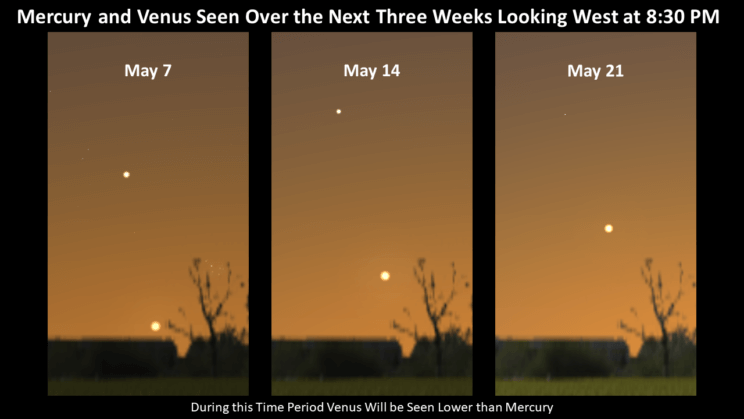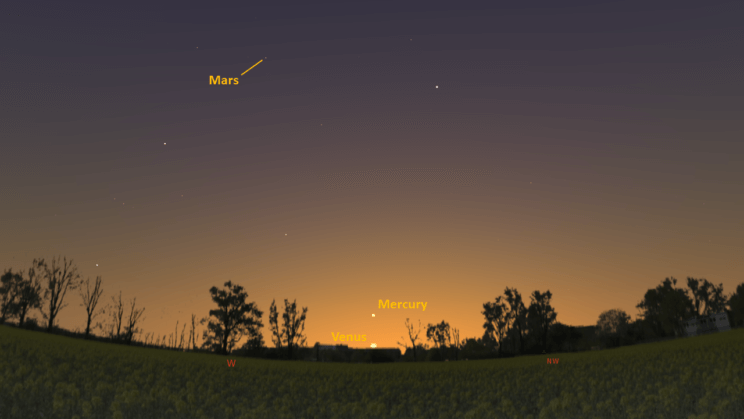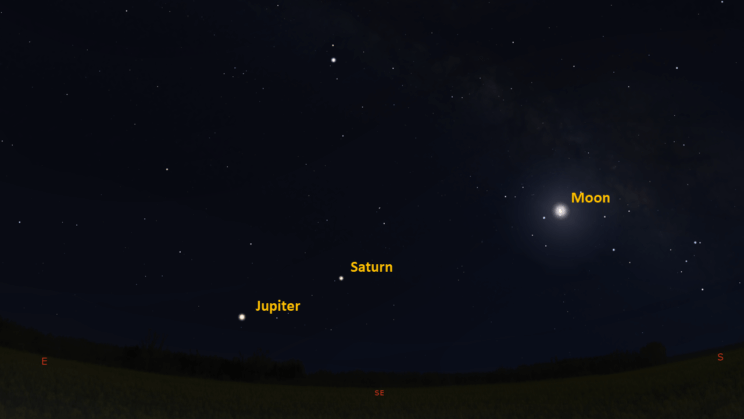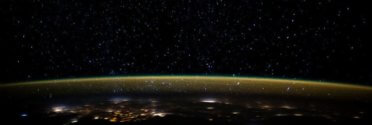This is the Saint Louis Science Center’s NIGHT SKY UPDATE for the week of Friday, April 30, 2021.
Information updated weekly or as needed.
Times given as local St. Louis time which is Central Daylight Time (CDT). For definitions of terminology used in the night sky update, click the highlighted text. If relying on times posted in Universal Time (UT), St. Louis is -5 hours when CDT.
Public Telescope Viewings
Star parties at the Saint Louis Science Center have temporarily been canceled due to recommendations from the CDC regarding COVID-19. All public telescope events are canceled until further notice. As conditions change, we will reevaluate and update this article once public observing events resume.
Observing Highlight of the Week

Mercury and Venus Seen through May 2021
Credit: Stellarium, EG
Mercury and Venus return to our western sky this week, becoming visible just after sunset. Both planets are called inferior planets, because they are closer to the Sun than Earth is. This is the reason Mercury and Venus are seen only after sunset in the west or before sunrise in the east. Both planets are starting their current evening apparitions, so right now, they are tough to see. However, as we progress through May 2021, both planets will be ideal targets roughly 30 minutes after sunset.
Mercury’s current apparition is one of its better even apparitions of 2021. Throughout May, we will see Mercury to the west northwest about 30 minutes after sunset. Mercury will reach greatest eastern elongation on May 17 when it will appear 22.1° from the Sun and set about two hours after the Sun. After May 17, Mercury will head toward the Sun until we lose it to the Sun’s glare. During evening apparitions, Mercury is brighter before greatest eastern elongation due to its phase. After greatest eastern elongation, Mercury will appear as a crescent phase and will start to dim.
Unlike Mercury, which will be visible in the west for about a month, Venus will be visible in the west for the rest of 2021. Venus will slowly elongate away from the Sun, reaching its greatest eastern elongation on October 29, 2021. Unlike Mercury, Venus becomes brighter after greatest eastern elongation due to how much closer the planet will be. If you have binoculars at home, they will be enough to reveal that like the Moon, Venus exhibits phase. After October 29, 2021, Venus will begin to exhibit a crescent phase as it heads toward inferior conjunction on January 8, 2022.
During May 2021, there are three planetary events involving Mercury and Venus. First, on May 12 and 13, the Moon will visit Mercury and Venus in the western sky. On May 12, a waxing crescent Moon with 1.3% of the lunar disk illuminated can be found next to Venus. On May 13, a waxing crescent moon with 4.3% illumination will be found near Mercury. The third planetary event occurs on May 28 as Mercury and Venus reach conjunction. On this date, Mercury and Venus will appear 0.25° apart.
May might be the month of Mercury and Venus this year, but if planets are your favorite target, all five naked planets will be easy to find this month. Mars will be found in the west after sunset, and Jupiter and Saturn are easy targets in the southeast before sunrise.
The Sun and Moon

The Moon as seen from the International Space Station, on July 31, 2011.
Credit: NASA
Sunrise is at 6:05 a.m. on Friday, April 30 and sunset is at 7:53 p.m. providing us with nearly 14 hours of daylight. Even after sunset, the light from the Sun will dimly illuminate our sky for about 1 hour and 40 minutes. This period is called twilight, which ends around 9:33 p.m. this week. For those with a sundial, local noon occurs around 12:58 p.m. this week.
| Day | Sunrise | Sunset |
|---|---|---|
| 2021-04-30 | 6:05 a.m. | 7:53 p.m. |
| 2021-05-01 | 6:03 a.m. | 7:53 p.m. |
| 2021-05-02 | 6:02 a.m. | 7:54 p.m. |
| 2021-05-03 | 6:01 a.m. | 7:55 p.m. |
| 2021-05-04 | 6:04 a.m. | 7:56 p.m. |
| 2021-05-05 | 5:59 a.m. | 7:57 p.m. |
| 2021-05-06 | 5:58 a.m. | 7:58 p.m. |
| 2021-05-07 | 5:57 a.m. | 7:59 p.m. |
| 2021-05-08 | 5:56 a.m. | 8:00 p.m. |
Moon
Tonight, moonrise occurs after midnight at 12:30 a.m. Moonset will occur at 9:51 a.m. on Saturday, May 1. On Friday, April 30 the Moon will exhibit a waning gibbous phase with 70% of the lunar disk visible. Last quarter moon occurs on May 3 at 2:50 p.m.
International Space Station (ISS) Observing

Visible passes of ISS from St. Louis for the week of April 30 occur during morning hours. The best passes this week occur on the mornings of May 1 and 2. Use the table below for information about these and other visible passes this week.
Catch ISS from St. Louis starting Friday, April 30
| Date | Starts | Max. altitude | Ends | |||||||
|---|---|---|---|---|---|---|---|---|---|---|
| Time | Alt. | Az. | Time | Alt. | Az. | Time | Alt. | Az. | ||
| 01 May | -2.2 | 04:16:17 | 25 | NW | 04:16:55 | 27 | NNW | 04:19:51 | 10 | NNE |
| 02 May | -1.9 | 03:30:32 | 29 | NNE | 03:30:32 | 29 | NNE | 03:32:37 | 10 | NE |
| 03 May | -0.6 | 02:44:44 | 14 | NE | 02:44:44 | 14 | NE | 02:45:18 | 10 | NE |
| 03 May | -1.2 | 04:17:41 | 12 | NW | 04:19:16 | 15 | NNW | 04:21:16 | 10 | NNE |
| 04 May | -1.4 | 03:31:51 | 19 | NNW | 03:31:51 | 19 | NNW | 03:34:09 | 10 | NNE |
| 05 May | -0.7 | 02:45:58 | 16 | NNE | 02:45:58 | 16 | NNE | 02:46:58 | 10 | NNE |
| 07 May | -0.7 | 02:47:04 | 14 | N | 02:47:04 | 14 | N | 02:48:21 | 10 | NNE |
| 08 May | -0.7 | 05:12:54 | 10 | NNW | 05:14:39 | 13 | NNE | 05:16:24 | 10 | NE |
Magnitude (Mag): The Measure of brightness for a celestial object. The lower the value is, the brighter the object will be.
Altitude (Alt): The angle of a celestial object measured upwards from the observer’s horizon.
Azimuth (Az): The direction of a celestial object, measured clockwise from an observer’s location with north being 0°, east being 90°, south being 180° and west being 270°.
For information about ISS flyovers and other visible satellites, visit www.heavens-above.com
Detailed information regarding all unmanned exploration of our universe, missions past, present, and planned, can be found at Jet Propulsion Laboratories:
The Visible Planets

Looking West, at 8:15 pm, April 30, 2021
Credit: Stellarium, EG,

Looking Southeast, at 4:00 am, May 01, 2021
Credit: Stellarium, EG
This week, five naked eye planets are visible. At the end of the week, Mercury and Venus can be found in the west northwest just after sunset. Mars is found in the west after sunset. Jupiter and Saturn can be found in the southeast before sunrise.
Mercury
Mercury is starting another evening apparition. The elusive planet will remain visible in the west through most of May. Mercury will reach greatest eastern elongation on May 17. After this we will see Mercury less and less each day as it heads towards inferior conjunction on June 10, 2021.
Venus
Venus is starting another evening apparition. It is still a little too close to the Sun to see easily see but with a clear view to the west northwest you might catch a glimpse of Venus about 20 minutes after sunset. Make sure the Sun has set before trying to find Venus this week.
Mars
Currently Mars appears as a 1.6-magnitude object that will be visible high in the west about 40 minutes after sunset. Mars sets by 12:11 a.m.
Jupiter
Jupiter is visible in the southeast before sunrise. Jupiter rises at 3:11 a.m. and will be easy to see in the southeast by 4:00 a.m.
Saturn
Saturn has returned to our morning sky. Saturn rises at 2:27 a.m. and will be easy to spot by 3:15 a.m. looking southeast.
James S. McDonnell Planetarium
Night Sky Update: April 30-May 8, 2021







